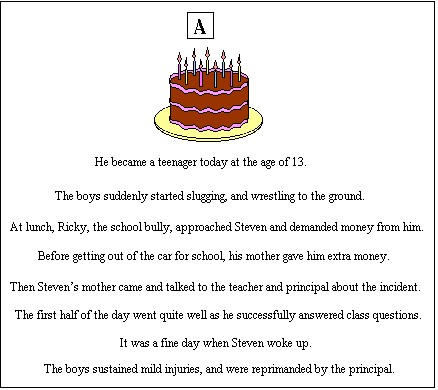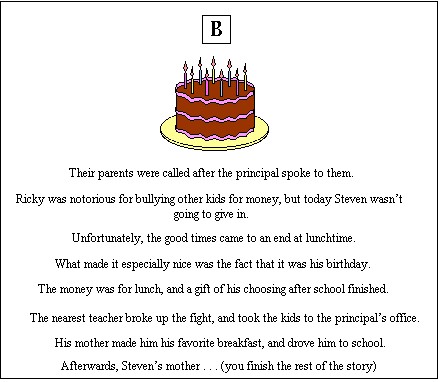
QUICK GUIDE
Key Words: Information gap, four skills, physical activity, sequencing, and questioning.
Learner English Level: Adaptable
Learner Maturity Level: Junior high and above
Preparation Time: 10-40 minutes
Class Size: 4-40+
Activity Time: 50-90 minutes
Materials: Very short story (10-15 lines), song lyrics, or poem; tape or pins; timer or clock; paper; pencils
This is an information gap activity that gets the students moving out of their seats, allows critical thinking and opinion formation, and utilizes all four language skills. This activity is adaptable to any class topic: It just takes a little imagination to construct. There are several steps to this activity. If any stage is too long for your class, you can easily delete sections to make it fit.
Choose a short story, song, or poem to use in class (see Example 1 at the end of the activity). Prepare a story that relates to the topic, grammar, vocabulary, etc. of your class and separate the information into two parts (A and B sheets) with alternating information listed randomly, which will act as an information gap activity later. Mix the sentences in each sheet (the students will have to rearrange them later). My stories are 6-10 sentences long per sheet (12-20 sentences for a full story), but please determine what is best for your students.
Step 1: Break students into two groups (A & B).
Step 2: Within the two groups, pair off the students.
Step 3: Explain to the students that each partner has a role. One is a Runner and the other is a Writer.
Step 4: Tell students that they have to get the information from the sheet which corresponds to their group. The sheet is outside the classroom and the Runner must read the information and relay it to their partner, the Writer. Of course, the Writer writes what they hear. And back and forth they go.
Step 5: Prior to the students starting the activity, tell them that when you yell "Change!" (or blow a whistle) they are to change roles (Writers become Runners and Runners becomes Writers). This will provide students with practice in all four language skills (reading, writing, listening, and speaking).
Step 6: When pairs are finished, have them compare notes with their neighbors.
Step 7: Now they have retrieved and dictated the partial story. Unfortunately, only one partner has a copy. At this time, have the other partner take out a sheet of paper and copy the sheet they have written together. Depending on class time, this can be dictated or visually transferred.
Step 8: As partners copy the information, go to each group and give each student a number (i.e., class of 40—A: 1-20, B: 1-20).
Step 9: When the copying is done, tell each student to raise their hand based on the numbers you call out: "Number 1's raise your hand, . . . that's your partner." Now A1 must get together with B1 and exchange information. This is the information gap activity between the two groups. Like the activity before this, the students must tell their information, not show it (unless time is running short).
Note: Walk around the class and monitor to see if there are problems or questions. Some students try to copy to get through the activity as quickly as possible, which cuts out the listening and speaking elements of the activity.
Step 10: Now the students have collected all parts of the story, but the sentences are in no particular order. The pairs must read the story and arrange it in a logical, sequential order of events. This is the critical and organizational thinking aspect of the activity. They must read the story, try to understand it and put it together like a puzzle. Sometimes different arrangements are possible in the story.
Step 11: After they have put their story together, they can confer with neighboring pairs.
Step 12: The teacher can have each pair read out their version or just read one sentence at a time, so other students can compare.
Step 13: Finally, the teacher can read the original story.
Step 14: This is the Question and Answer part of the activity. Prepare a set of questions for the students to discuss in relation to the story. They can ask each other in class or take it home as homework. Either way, this allows the expression of opinions about the topic and story, as well as promoting comprehension and thinking skills.

